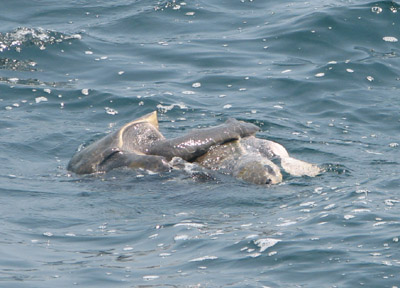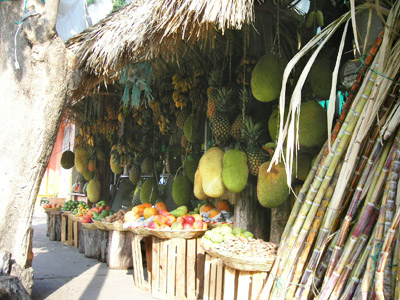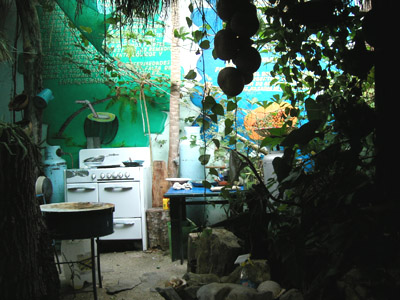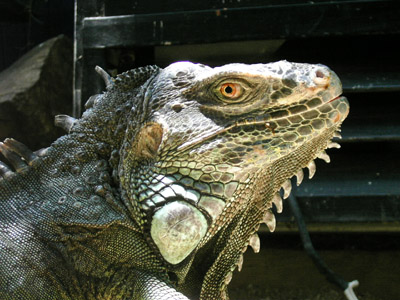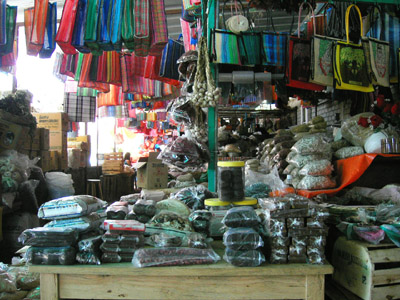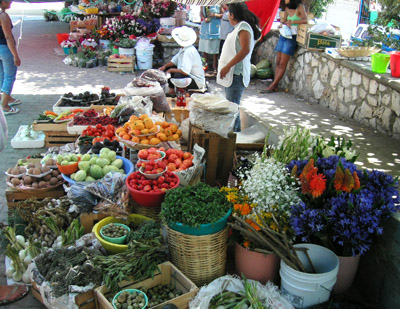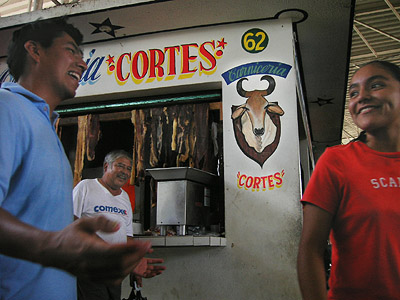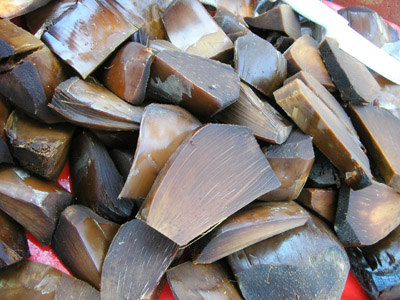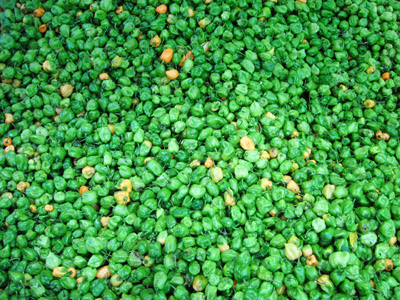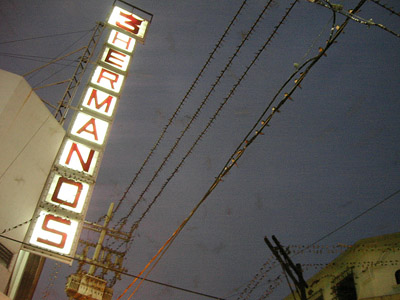Tehuantepec epic
Monday, May 1st, 2006We were worried about the weather situation for crossing the Tehuantepec and had been monitoring NOAA and weatherbuoy.com for the past few days. Don on Summer Passage had been harping on about the Tehuantepec for over four months because the place has some special weather patterns, namely it blows like snot ninety percent of the time. Gales! With a yearly average of Force 6 (which is around 30mph and, technically, a gale). Don has made it a significant part of his weather dispatch for months to lecture about the intricacies in predicting Tehuantepeckers (the Big Windy); basically when there is pressure in the Gulf side, and less pressure on the west side, the low-lying isthmus allows all that wind to equalize by blasting holy hell into the Pacific. I read that top-heavy vehicles have been blown right off the road at times; basically, the isthmus of Tehuantepec is bus plunge central. It doesn’t take much to create the big wind and Don alone appears singularly able to predict nearly all of the blows. So I am greatly chagrined to discover that not only does he come in patchy this far south, at the entrance to the Tehuantepec, but he simply stopped predicting them altogether.
In addition to our own weather research, we talked to Enrique from the marina at Hualtulco and he showed us a 10-day buoy weather prediction of the weather. This showed 5-15 knots average over pretty much the entire length of time (what we’d been seeing as well). Basically, the high wind season is officially over starting May so the wind is relatively mellow, unless there is a hurricane. He recommended that one take off from Punta Canejo and sail due east, thus putting one out of the way of Salina Cruz and shrimping/fishing traffic and safely past the shoal entries of two bays. Raines, however, recommends that one stick to the coast the entire way, cutting across Bahia Ventosa (“The eye of the beastâ€) and then hugging the beach just beyond the breakers until you get to the 94-degree longitude (“One foot on the beachâ€). This is a distance of around 60 miles and the logic behind hugging the beach is that if there is a major blow, the seas don’t have enough fetch to get ugly—your sail may be exciting, but the water will be flat. You might not be surprised to discover that I was all about the whole hugging the shore thing and Joshua entertained the idea that we should just head straight across. I won, of course, since I pitch a better fit than he does.
We left Sunday morning for the 40-mile run to Salina Cruz. I had it in my head that we might get there and anchor for the night to be sure we were properly rested for the crossing. If the anchoring turned out well, we could maybe hang out for a bit, perhaps buy some property, just long enough so I would be absolutely ready. We had some good west wind in the afternoon and made our usual night entry into a strange port after I flatly vetoed the option of just going for it while we had perfect wind on our tail. I did not want to cross at night because it was a black moonless one and there was lightning flickering here and there. I figured the lightning would only go away if I went inside the cabin and shut my eyes, and I was right. We circled the anchoring area trying to select just the right spot and finally, with uncanny accuracy, dropped the anchor on the only fishing net in the entire bay. After a few minutes, the wind died entirely and soon shifted around to gust violently out of the North (that’s the Tehuantepec direction). It did this all night and continued after the sun came up. We awoke to polite fishermen trying to fetch their Pepsi bottle buoy out from between our ama and main hull and helped them disentangle our boat from their nets.
We kicked around for a bit trying to decide what to do because the wind was still gusting noisily from the north. Around 8am, it mellowed to the point where it was averaging 20 knots and we pulled anchor. We put up the storm jib, a tiny sail about the size of a handkerchief but built like a flak jacket, two reefs in our mainsail, and pertly sailed away from anchor. Bahia Ventosa is conveniently located only a mile or so from Salina Cruz, right on the other side of a massive rocky headland. In this rocky headland are a few weather-gouged channels which do fantastic things to the wind flowing over it; we would alternate between flopping about and then heeling over as a gust came blasting down through a small pocket in the rock, shooting ahead with just enough momentum to get us through the next lull. This made for a dramatic entry into Bahia Ventosa itself since the biggest, wind-blockingest rocky bit of all is right at the end. We flopped in the current for a bit and then suddenly we found ourselves in the “eye of the beast.â€
Not entirely calm in mind and spirit, I kept myself occupied by noting wind speed and wave conditions and taking photos. Wind speed was 25-28 with small gusts to 30 (Force 6 city; an average day, apparently). Waves were acceptable since there was only about a mile of windfetch. Here’s a photo:
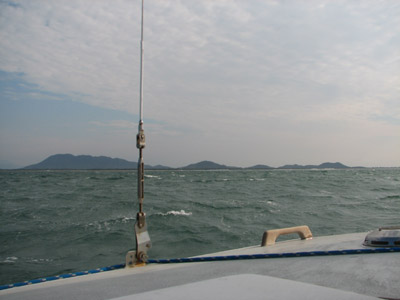
It took us probably only 30 minutes to get across the bay to the beach at the other side. I believe Joshua fully enjoyed himself, “Hey this isn’t so bad! We’re almost across and then we’re pretty much homefree.†We headed straight for the beach and then when we hit 35 feet or so–a depth alarmingly close to massive wave action due to an impressive swell–we altered course by a degree or so to follow the beach. Wind speed increased to be 30 solid with gusts around 35. It felt like we were pointing the boat 45 degrees into the beach but with the wind blowing so hard, our course itself stayed nicely parallel. We were also pointed as high into the wind as possible even though it seemed, heading in an easterly direction and the wind out of the north, that we should have an easy beam reach (wind broadside to boat).
Thirty knots of wind in your face wears you out. The whole one-foot-on-the-beach tactic however, reduces greatly the drama; 30 knots and the boat skids along smoothly. No bumps and no bashing through the waves. Going below, aside from the shrieking rigging and running water noises, was a strangely tranquil experience. The boat almost felt like it was at anchor. Once you had to go back up to the cockpit (where we don’t have any sort of dodger), the wind attacks once more and presses on you. I got earaches and when particularly strong gusts would hit, my ears would pop as if we were going up a mountain. We got a lot of spray, but primarily from the waves breaking on the shore. They were amazing: a combination of steep beach and large swell produces a fast bumping up of water from which a curtain of mist blasts straight up for a good fifteen feet. This blows back as the first wave of spray. Then the wave breaks and there is mist blowing up from the impact of the curled wave in addition to the air pockets trapped inside the wave curl exploding out the backside of the wave. All this makes giant mist plumes which blast up into the air and then straight back at us. We had to keep wiping our sunglasses off. The camera was a mess and Joshua thought our binoculars were shot until he realized that they too suffered extreme salt mist build-up that apparently outsmarted the plastic eyepiece protectors. I tried in vain to get good photos but never could get the timing just right on a good set.
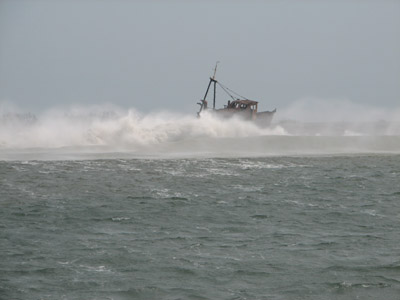
In this image you can see streaks beginning to form on the water surface. This is because the wind actually increased more and we were seeing 35 steady with gusts to 40. The whitecaps were breaking and then the wind would smear the whitecap all across the surface of the water. We had to be fairly diligent with the helm keeping the boat tight into the wind and parallel to shore. We have a small windspeed indicator that is used for ultralights and hand gliding and such. We kept taking it out to check wind, then putting it away in its little felt tube and then getting it right back out again because damned if the wind didn’t seem like it increased the moment I put the wind indicator down. It did increase too, I was shocked and near-hysterical to discover. Now it was blowing solid 35-38 with prolonged periods of 40 and gusts to 50. Not pretty. The gusts of fifty felt terrible and the mast groaned and I made Joshua take the main down. The constant abuse of the wind over the past several hours had me feeling belligerent, not to mention I was sort of freaking out over the steady increase in windspeed; it was supposed to be no more than 15 according to the weather quacks, now it’s pushing 50 and I hated to think it could increase still. Dramatic changes in sailing technique are not well justified by my simply being scared so all suggestions (demands) of sail reduction were backed up with flimsy excuses that I am just worried about the rigging. And being dismasted. And sea snakes.
So now we have only the little storm jib up. The little storm jib that could. And it’s doing a fine job of propelling the front of the boat; the back of the boat is lagging though. We have to steer with the rudder hard over to keep the boat parallel, the wind is just pushing the bow off. After a while, we are having a hard time staying on the beach and we’re heading offshore; perhaps the wind increased still more but I stopped checking. We have to either put the main back up or start the outboard. So, uh, we start the outboard (you know, the rigging). And suddenly that’s all we need to keep our ass in line with the beach and the steering goes back to normal. We couldn’t even hear the motor at all over the wind; to check if it was still running we had to duck below.
After ten gerjillion hours of this, we are approaching the first shoal—an entrance to Bahia San Francisco—and you must head offshore about a mile to avoid the breakers. We’ve been sailing at probably less than a quarter of a mile since we hit the beach and I’m pretty apprehensive about going offshore. We can’t continue with the motor/storm jib setup, certainly, since the waves will increase once we get any distance from shore. I face the inevitability that we need to re-raise the main. Lucky for me and my shredded nerves, the wind backs off to a mellow 30 solid and going around the shoal is a breeze. (Har har, cough.) The breakers are dramatic as promised in Raines’ guide and inside the bay we can see a very quaint village of steep palm-roofed buildings. We see some people on the beach too, the first we’ve seen all day since Bahia Ventosa, where people appeared to be jogging! In a gale! Once we get around the Boca de San Francisco, the wind is at the point where it really is broadside and the point of sail less dramatic (the further off the nose the wind is, the less pressure it puts on the rig). The wind actually starts to mellow though and before we know it, reefs are shaken out, it’s quiet, and we’re barely moving along at five knots.
We’re now in Chiapas and the coast has not changed in appearance since we hit the beach. We end up passing only one or two small huts and animal pens and two guys on horseback. We wave at them.
Here’s what the coastline looked like for the last 200 miles of Mexico, all of Guatemala (except more hazy), and all of El Salvador, so far.

The lighthouse is one of two or three we passed, just randomly in the middle of nowhere as far as we could see. Blink, blink.
The wind was very light as the day ended and we had full sails up. We were still within the Tehuantepec windy zone so we were still keeping fairly close to shore. As it got dark, the pretty fluffy white clouds that had been forming over the shore began flickering and by 8pm, we got hit with our first squall. I can’t even tell you how stoked I was to see both 50 knots AND an electrical storm all in the same day. Joshua regarded the events with extreme nonchalance even once it really looked like the storm was headed our way (the wind still was blowing in the opposite direction). When it hit us, the wind stopped blowing for a minute, then changed direction and blasted us with cold, curious-smelling air. That was the weirdest part: it was a really cold wind–maybe twenty degrees colder than the air temperature. It smelled a little like fresh city pavement during a rain with a lot of old electric mixer tossed in. A very strong and eerie smell. The clouds were very black and there was a lot of lightning. Two reefs went back into the main and Joshua put the storm sail back up. Fortunately, after the initial front of the storm, the wind was pretty mild; unfortunately, I was sufficiently spooked and not allowing any more sail area and the wind was coming from all over the place. Our speed was something ridiculous like two knots in a totally random direction and we were bashing all around in circles (so it seemed). I couldn’t tell what direction was what and we couldn’t see anything at all unless there was a lightning bolt, in which case all we could see was an approximation of the inside of the sun followed by orange and blue streaky effects while our optical nerves spasmed and convulsed.
I admit to being particularly concerned with the lightning. What the hell are you supposed to do if you get struck? Being obviously the only thing around for 200 miles with a tall pointy aluminum stick up in the air was similarly disconcerting. I’ve heard that people drape chain around the rigging to make a path to the ground; but Joshua said you only do that when at anchor. Also, put all electronics in the oven—or, lacking an oven, um, put the GPS in the pressure cooker? I was chagrined that we had not yet backed up our photos. Joshua’s response was very rational to all my storm fears and tactical suggestions; “We’re not going to get hit by lightning. The worse thing that will happen is it’ll blow a hole in the boat and we’ll have to sail to shore and drop anchor.†(Um, but you just said…) After that I was obsessed with staying within 60 feet depth (this was still fairly far offshore since the coast was very shallow); that was our maximum anchorable depth, more or less. I was similarly obsessed with the rigging, the pressure cooker and which direction shore was, and then it started to rain. Then I became obsessed with the GPS as the batteries coincidentally failed at the exact moment it got totally soaked in the downpour and I thought I was going to faint.
By this point, I think the wind itself was blowing straight down out of the sky. The rain was coming down in fat hard pellets and had the effect of flattening all the whitecaps into gray haziness. The lightning was all over the place too. “This is maybe not a squall; usually you can see both sides of it. This must just be a normal storm,†was Joshua’s enlightening assessment of the situation after I complained that it wasn’t ending yet. All whitecaps disappeared and the sea was just lumpy. We had our rain jackets on by this point but they were a little late in coming and with the water just running down our necks, they functioned only as windbreakers. Both of us were thoroughly wet. The rain lasted only maybe 20 minutes and then slacked off to random spitting here and there. We tacked and headed back towards shore (we were in 80 feet and I was becoming preoccupied with our depth in the event of being gored by lightning). I know that the usual tactic is to head offshore in a storm but that sort of rational thought will get nowhere with me. The wind was still totally wonky and it took a million years to get back in the 60-foot range. The rain began again and this time was like one of those obnoxious showers they have in gym lockers or cheap hotels that atomize the flow into needle-like projectiles.
We checked the clock on the GPS, which was working fine after changing the batteries and was staying dry in a ziplock, and we’d been bobbing around in the rain and lightning for over three hours. The wind slacked off to next to nothing punctuated by gusts now and again and we decided to just head in to around 40 feet and anchor. We were not able to sail as such and the thought of motoring through the night in the rain and lightning was not agreeable. We slept a little, checking the anchor every hour or so and marveling at the fact that there was still lightning all around, and it continued to rain all night long.
The next morning, the boat was sparkling clean. Nooks and cracks I’d been trying to dig the grime out of for months were spotless. It was sort of breathtaking.
There was still no wind and we motored the remaining distance around the second bay boca/shoal and, passing the 94-degree longitude, we were officially clear of the Tehuantepec.

